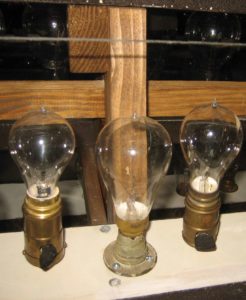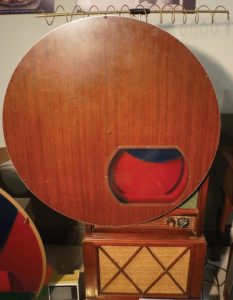
At the front of the long main exhibit hall presides a larger-than life portrait of Thomas Edison, the prolific inventor of, among many other devices, the phonograph, the practical and long-lasting electric light bulb, and the motion picture camera. The Edison portrait gazes at the vintage self-playing machines and technology that line the crowded walls and aisles.
DeFord greatly admires Edison, another successful non-college-educated businessman, who persisted despite epic failures, bankruptcy, and endless patent litigation. “He persevered,” DeFord said, “even when people laughed at him.”
At intervals along the rope-fenced aisles, entertaining, informative interactive touch screens on movable wood stands allow visitors to see and hear prerecorded performances by the antique automated musical machines and early technology. “Most museums have a few demonstration machines, said VRPS’ Sargent, “but the rest don’t operate. In this museum, every machine works.”
Midway down the second aisle, a replica of Edison’s phonograph from December 1877, the first to record and replay sound, stands out for its primitiveness among the cache of early machines. Made by California collector and machinist Elmer Jones in 1983, the replica consists of a crude, hand-powered, grooved cast-iron cylinder wrapped in tinfoil revolving on a long shaft. Edison’s original phonograph now sits in the Smithsonian.
The oldest phonograph in the collection is from 1893, several years after Edison had moved on from tinfoil for capturing sound to his Class-M cylinder. Brown, a quarter-of-an-inch thick, and made of wax, it’s the forefather of today’s vinyl LP.
The bulb displays in the next aisle of the museum are “world-class,” according to Mike Grimes, auction director for the VRPS. One display features more than 100 incandescent light bulbs from 1882 through 1925.
Though nearly two dozen inventors worked on it, Edison is often credited for creating the practical, affordable light bulb. His 1879 bulb outstripped his competitors’ because his had the right incandescent filament, a higher vacuum with use of the Sprengel air pump, and high resistance to current flow necessary for lower electricity draw. His U.S. patent application for electric lights, filed November 4, 1879, was inspired by a carbonized thread filament that in a test trial had burned for 13.5 hours.
Edison then launched an exhaustive search for the ideal filament for lower electricity conductivity and longer life. Edison reportedly dispatched assistants all over the world with personal letters bearing his signature. In his letters to the president of Brazil and officials of the West Indies, Edison asked assistance in finding a “vegetable fiber capable of being used in Electric Flow Lamps.”
Apocryphal as it sounds, Edison got the idea for his ideal long-burning, electricity-resistant filament while relaxing in Wyoming on an 1878 trip with his team to observe a total eclipse of the sun from the Continental Divide. He had examined material from bamboo fishing poles. In tests, the carbonized bamboo filament lasted 1,200 hours. Edison bulbs with bamboo filaments went into production in late January 1880, and other manufacturers followed.
After a Hungarian company began marketing a brighter, longer-lasting tungsten-filament bulb in 1904, General Electric, a new company formed by the merger of Edison General Electric and Thomson-Houston, found a way in 1911 to weld brittle tungsten into coiled ductile wire, similar to that used in commercial incandescent light bulbs today.
“It was such a good improvement,” said VRPS auction director Grimes, “it’s lasted over a century.”
Among the antique radios, jukeboxes, coin-operated silent and sound film machines, and post-WWII TVs lining the south wall, near the entranceway, are historically important, even precedent-setting artifacts, ones crucial to the development of early 20th-century technology.
In the radio section, a trio of spare batteries with a vintage headset sits atop a handsome oak cabinet. Below, a black Bakelite front panel catches the eye with an inverted tube. A prominent spherical vacuum tube hangs upside down from a brass socket with red and green rubberized, coated wires at the bottom, flanked by two large dials.
This is the homebrew radio possibly made from a factory-supplied kit outfitted with the extremely rare de Forest Audion.
“Previously, early radios employed an itty-bitty potted crystal mineral to receive radio signals,” Wilkins said.
The Audion vacuum tube, Wilkins said, “was useful for radio reception. De Forest tried to explain it to the scientific community, but he didn’t really know how it worked. But he knew how to make them.”
With modifications, AT&T, which acquired some of de Forest’s patents and rights, used the invention for the first transcontinental telephone calls in 1915 and the first international radio transmissions that same year.
The museum’s Audion contains double plates and double grids with a single filament between them for enhanced reception. The century-old tube in the homebrew set still functions, Wilkins said, but reception is better at night. “When there are no clouds or thunderstorms,” he said, “I can get AM news and weather with my 80-foot antenna suspended from trees.”

Further down the south wall, a bevy of handsome jukeboxes from nearly a century ago conjures up a time when these machines were the Spotify and iTunes driving the hit songs of the day. The Regina Hexaphone, from 1909, the oldest multi-selective jukebox in the collection, was one of the first popular, successful fully automated coin-operated jukeboxes ever made.
Standing a little over five feet, the well-polished solid oak console offers a sloped glass front through which you can watch the movements of the mechanism, gears, reproducer, and the carousel containing six revolving cylinders.
What was everyone in hotel lobbies, soda fountains, or penny arcades going apey over? Hits like “Wild Cherry Rag,” “Gun Fire March,” “When the World Don’t Treat You Right,” and a few others.
[box_info]
Listen to the Wild Cherry Rag here
https://soundcloud.com/anthonymariani/wild-cherry-rag
[/box_info]
“This one plays 2-minute cylinders with 100 grooves per inch,” Wilkins said. “Later cylinders played for four minutes with double the grooves per inch.” Eventually, cylinders were phased out by disc records.
The marvelously entertaining silent and sound film machines viewable one at a time on the south wall represent the forerunners of modern motion pictures. The museum’s very rare coin-operated, motor-driven Bennett Flip Reel Movie Machine from 1895 stands six feet tall. “A lot of these machines were hand-cranked,” Wilkins said. “The motor-driven, which produced a less jerky performance, were rarer.”
For a penny, arcade customers could peer through a cupped viewer atop the nickel-plated, appliquéd oak cabinet into a Mutoscope, an early version of the film projector, patented by Herman Casler in 1894. When a coin turned on the Bennett, a roll of cards holding actual photographs, like a large circular Rolodex, flipped past so fast, the depicted action looked like a movie.
At the back of the tall Bennett cabinet, an attached oak-framed yellow-and-orange poster advertises The Pirates’ Sudden Raid.
“Drop a penny in there,” Wilkins said, “the motor kicks on and runs the reel, and you get a 30-second movie of a pirates’ invasion of a ship. You see a swordfight, pirates tying up the captain, gagging him, and lots of action. I love it.”
Along the opposite end of the south wall, near the entrance where tours begin, a unique electro-mechanical combination reminds visitors of the early ’50s, when America transitioned to color TV. The 12-inch Philco black-and-white 50-T1403 from 1950 and the Col-R-Tel mechanical color wheel adapter available since 1951 gave the public a taste of the color TV that came out in 1954.
When a television station broadcast a show in color, the Philco’s black-and-white TV tube received it as a two-tone black-and-white broadcast, but the revolving wheel of blue, red, and green filters rapidly spinning in front of the 12-inch round screen amazingly transformed it into a composite color-viewable picture. The Col-R-Tel extracted the primary blue, red, and green video information from the television signal and sequentially applied the signal to the black-and-white picture tube when the corresponding color signal matched the corresponding color filter.
“The color wheel produces all the necessary color to receive a color broadcast,” Wilkins said. “The wheel blocks out half the frames because it can’t spin quickly enough to color them all, which is why it gives off a flickering appearance when you see it, because you’re only seeing 15 frames a second instead of 30.”
The museum is now home to two new items that Wilkins scooped up over the last year, items that he said “almost never” come on the market. One is a 100-percent original “Howler,” the first mass-produced external loud speaker, made by Western Electric. “It amplified sound from a radio or telephone,” Wilkins said. “It wasn’t meant to be spoken into.”
It enabled railroad engineers to communicate with personnel on the train in conjunction with a telephone or multiple listeners to hear a radio without headsets.
A Midwestern telephone museum was partially liquidating its collection. “I was lucky,” Wilkins said. His wall-mounted “Howler” predates the table models and those later deployed in phonographs, public address systems, and theaters for talking motion pictures.
The other new acquisition came via eBay and is the first successful receiver for limited ground-to-plane or intra-plane communication in military combat: the famous World War I U.S. Army Signal Corps radio receiver Model S.C.R. 59. “If a squadron was flying out, or a commander was giving instructions from another plane,” Wilkins said, “this receiver picked up the dispatch.”
Previous crystal sets hadn’t been loud enough to overcome noise in the open cockpits –– even with headphones built into helmets –– or strong enough to withstand the flight’s vibrations. “It took until October 1917, seven months after America entered the war,” Wilkins said, “for Western Electric to perfect and ship the ground-to-air receiver. … Men’s lives depended on them.”
Since Wilkins knew the seller was from North Carolina, where Western Electric had tested its receivers for the army, he felt comfortable bidding as high as he could in the auction’s last second. And won. The shipped S.C.R. 59 receiver bore the Western Electric decal, the original finish on its oak cabinet, and the period’s anti-fungal coating on its wires.
Asked for his feelings after the museum opened for tours in the fall of 2014, the 94-year-old DeFord said, “I’m not done yet.”
Veteran journalist Barbara Kevles has written about art, antiques, and music for Salon, Maine Antique Digest, Art Al Dia, and the Fort Worth Star-Telegram. Her journalism collections reside at the John F. Kennedy Library, Yale University Beinecke Rare Book and Manuscript Library, Stanford University Libraries, Museum of Modern Art, and Bryn Mawr College Library Special Collections.












I appreciate the article by Barbara Kevles in this recent Fort Worth Weekly magazine entitled “Old School Museum”. Ms Kevles did an outstanding job of capturing the essence of a museum sitting near the center of the DFW Metroplex, a museum that is so incredible in it’s humble beginnings, and yet so carefully put together as to rival the finest museums in this country. So many historical artifacts are sitting in Duncanville that it is a shame more folks do not know of it’s existence. Hopefully Ms Kevles’ article will awaken the citizens of this part of Texas and encourage a resurgence in the historical study of these technological dinosaurs whose current versions play such a large part in our daily lives.
Jim Sargent, President Vintage Radio & Phonograph Society